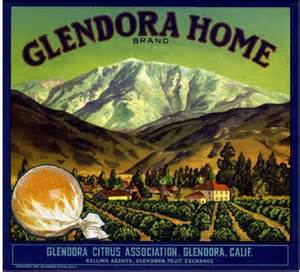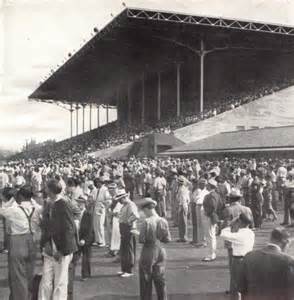Bread and Butter Days
by Trisha Faye
IN MY HOMETOWN
“… this is your hometown …” Bruce Springsteen croons on the radio, evoking memories of my own hometown; Glendora, California.
 In its early days, Glendora, incorporated in 1911, was a thriving citrus community – as many of the southern California towns lining the San Gabriel Mountains were. Proclaiming itself “Pride of the Foothills”, this small community was a natural for orange groves. Oranges thrived in the moderate climate, warmed by Pacific coast winds and sheltered by the foothills to the north. Aided by the railroad lines built across the nation providing easy transportation, orchards and packing houses sprang up across the inland acreage.
In its early days, Glendora, incorporated in 1911, was a thriving citrus community – as many of the southern California towns lining the San Gabriel Mountains were. Proclaiming itself “Pride of the Foothills”, this small community was a natural for orange groves. Oranges thrived in the moderate climate, warmed by Pacific coast winds and sheltered by the foothills to the north. Aided by the railroad lines built across the nation providing easy transportation, orchards and packing houses sprang up across the inland acreage.
When I grew up there in the 60’s, there were still many orange groves, although not near what was around when my mother and father grew up in Glendora in the 40’s and 50’s. Today few groves still exist.
The lure of orchard work drew many good men, looking for steady work in the post-Depression years. It called to my Uncle Johnny, who worked at the Widman groves for many years. My Grandpa Jones soon followed, joining him in the orchards for a time, as he and Bea raised their family on Leadora Avenue.
 President Taft himself was enamored of this sweet golden fruit. The June 10, 1911 Glendora Gleaner, the local paper at the time, reported that “… President’s well know preference for the California oranges. They are packed by the Glendora Citrus Association in quarter sawed oak boxes and put together with brass screws, and shipped once a month regularly to the President. The order for the White House supply was placed with the Glendora Citrus Association to fill by the Southern California Fruit Growers Exchange, because of the well known and recognized superiority of the fruit raised in the Glendora district …”
President Taft himself was enamored of this sweet golden fruit. The June 10, 1911 Glendora Gleaner, the local paper at the time, reported that “… President’s well know preference for the California oranges. They are packed by the Glendora Citrus Association in quarter sawed oak boxes and put together with brass screws, and shipped once a month regularly to the President. The order for the White House supply was placed with the Glendora Citrus Association to fill by the Southern California Fruit Growers Exchange, because of the well known and recognized superiority of the fruit raised in the Glendora district …”
In 1915, the Citrus Protective League of California estimated that California’s citrus production exceeded $200 million dollars, from a total of 208,000 acres of citrus groves.
Life is always in flux, the only constant being that things are always changing. This goes for the popularity of the citrus industry also. In “Oranges for Health – California for Wealth”, Vincent Moses attributes real estate development and population growth following World War II as factors responsible for the decline of the citrus industry. He states, “One local grower mused that it was feasible to grow oranges when his land was worth $11,000 per acre, but when land values soared (to) $30,000 per acre orange growing ceased to be as compelling.”
Whether Glendora is filled with orange groves or rows of brand new houses, the scent of fresh orange blossoms, or the lyrics of a popular song, still take me right back to my childhood days, walking past the orange groves on the way to school.

